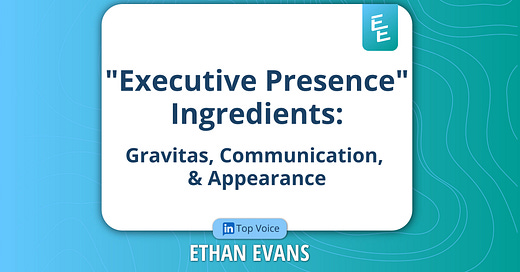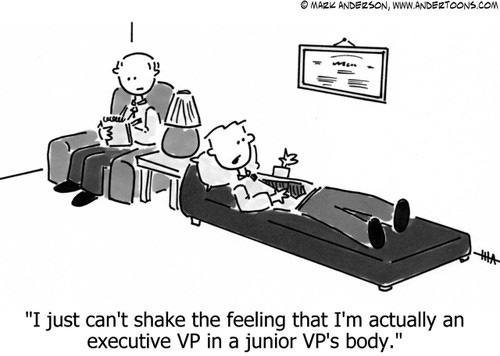"Executive Presence" Ingredients: Gravitas, Communication, & Appearance
5 strategies to improve your executive presence
Hello, it’s Ethan & Jason. Welcome to today’s article of Level Up: Your source for executive insights, high performance habits, and specific career growth actions.
In celebration of Maven naming our popular course Stuck at Senior Manager - How to Break Through to Executive (1,000+ alumni, rated 4.7/5) “The Top Leadership & Career Course” we are offering 25% off. And, this is the first time in over a year where Ethan will teach the course fully live with new updated content to match the 2025 environment and challenges.
Use code MAVENTOP25 at checkout.
This offer ends March 11.
(this is the biggest discount offered—thank you Maven for the support!)
My client Sam worked hard, delivered quality work, and got along with everyone. But, in big meetings he rarely spoke. When put on the spot, he rambled.
Sam got good ratings but was never promoted past senior manager.
Why?
Sam lacked Executive Presence (EP).
He could not command a room, hold attention, and present himself as a smart and decisive leader.
Aspiring executives are often told that they lack executive presence, but they aren't given a specific definition of what this means.
Executive presence is tough to define because it isn’t one skill—it’s actually composed of many skills. People often think of it as public speaking, but in reality there is much more to it.
Author Sylvia Ann Hewlett breaks down executive presence into 3 categories, defining it as a mix of:
60% gravitas (how you act)
30% communication
10% appearance
”Gravitas” is composed of the things that make you a serious leader, worthy of attention and respect. The two dominant traits in this regard are confidence and decisiveness. People follow leaders who seem composed and sure of themselves, including under the pressure of a crisis or a tough question from another leader. Having a body of correct work or accurate results that have been verified or accepted in the past is also a form of gravitas—it forms your reputation (it’s your track record).
Communication skills are often the first thing people think of, but they are surprisingly less important than gravitas. Communication skills include speaking, but also your ability to hold attention, manage a room, read an audience, and present your authentic self.
Appearance is the least important, but it does matter in two critical ways. First, appearance is not about being attractive. It is about showing that you pay attention to your dress and grooming. This helps you show that you are a person who takes their work seriously and expects to be taken seriously in return. Second, appearance matters most as a first impression. It shows professionalism and opens the door for you to showcase your gravitas and communication skills.
To improve your executive presence, you must first identify which of these areas need work and then make a plan to improve them.
5 strategies to consider:
For public speaking, find small, safe audiences to practice in front of. Consider joining a Toastmasters club.
To learn to read a room, partner with a friend after a meeting and discuss what each of you saw.
To display calm and practice emotional control, try meditation and build your emotional intelligence skills to help you handle crises.
To increase your influence, read “How to Win Friends and Influence People” and then prepare your arguments in advance (rather than on the fly).
Finally, for appearance, consider a professional stylist like a Nordstrom personal shopper if you feel you want to address that. The old saying, "The clothes make the man" exists for a reason (like all old sayings, it has its limitations, but also some value). I find for many people the clothes or other appearance features are as much so that the person themselves feels comfortable that they fit in as it is for how others actually respond to them. The right clothes can feel like a suit of armor.
If you found this helpful and want to go deeper on executive presence and what it takes to get promoted from Senior Manager to Executive, consider our signature live online course Stuck at Senior Manager - How to Break Through to Executive (25% off for a limited time).
With regard to executive presence specifically, in the course, Ethan covers what is it, the controllable inputs, how to grow your EP, how it is viewed from your key stakeholders (e.g. leadership, peers, and direct reports), where to seek out moments to showcase your EP, how EP plays into culture and bias, how introverts can spotlight their EP, the 2x2 EP Matrix, and additional resources.
Audience Insights
Additional advice and stories shared from readers:
From Sue Bethanis, my co-teacher for our popular executive course Cracking the C-suite 'How to Get and Master Key Executive Roles' — “You hit all the main points. Only addition is “find common ground” especially when starting a conversation. Like when we are interviewing: we often think of the interviewer being the one trying to make the interviewee at ease. If you’re interviewing, likability is key, so putting the other person(s) at ease with what you have in common (like LI connections, travel, weekend plans) goes a long way!”
From Omar Halabieh (Amazon Tech Director) — “I wanted to highlight two of the points that have had a direct impact on my career and those whom I mentor - 1) investing in communication skills as first class competency - in line with point 1 above; 2) on point 4, Cialdini and Carnegie’s work are two of my most gifted books - for influence and interpersonal skills.”
More Articles on Executive Presence
Up Your Game to Influence Senior Leaders with Ethan Evans & Sue Bethanis
How to Speak like an Executive and Command the Room — with Ethan Evans & Harriette Cole
Embracing the Super-power of ‘Effective Writing’ to advance your Executive Presence a guest post by Pratik Sharma
Connect With Ethan & Jason
Follow Ethan on LinkedIn.
Get Ethan’s career advice on YouTube.
Connect with Jason (Ethan’s COO) on LinkedIn.
Learn more about Ethan’s live online courses and on-demand courses.
Contact us for corporate training, speaking, podcast appearances, and more.
Many subscribers expense this newsletter to their Learning & Development budget, use this email template to send to your manager.








